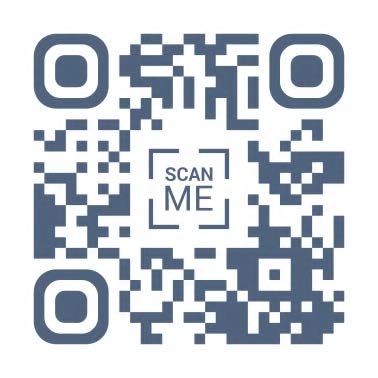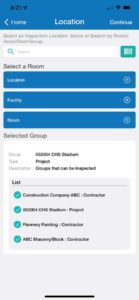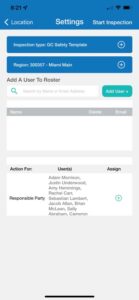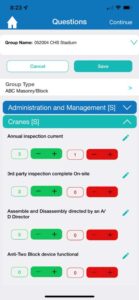Whitepaper: Establishing a Safety Assurance Methodology (SAM)

The essential objective of a safety management system is to provide for a systematic approach to achieving acceptable levels of safety risk. At the start, a system analysis is conducted, hazards are identified, risk is assessed, and controls are put into place until the risk is determined to be an acceptable level to those working within the system. In an ideal world, these controls (e.g., PPE or an engineered system) would always be used, always be effective, and never be circumvented. Knowing this idyllic scenario does not exist, a Safety Assurance Methodology should be incorporated into systems to verify the presence and validate the efficacy of controls on a recurring basis.
Continue Reading
Fill out the form to continue reading
Establishing a Safety Assurance Methodology (SAM)
From Vision to Action
Safety Assurance Methodology (SAM)
The essential objective of a safety management system is to provide for a systematic approach to achieving acceptable levels of safety risk. At the start, a system analysis is conducted, hazards are identified, risk is assessed, and controls are put into place until the risk is determined to be an acceptable level to those working within the system. In an ideal world, these controls (e.g., PPE or an engineered system) would always be used, always be effective, and never be circumvented. Knowing this idyllic scenario does not exist, a Safety Assurance Methodology should be incorporated into systems to verify the presence and validate the efficacy of controls on a recurring basis.
“Safety is not the absence of events; safety is the presence of defenses.” – (Conklin, 2012)
While a safety management system (SMS) is comprised of many components, this paper will focus on safety assurance using the safety inspection and observation process coupled with subsequent risk analysis of the findings. Even in safety management systems that feature reasonable risk management processes, the safety assurance component may be undervalued and subsequently, underutilized. This is because fulfilling regular safety performance monitoring and review takes considerable planning.
The framework for a robust and effective safety assurance methodology program should consist of the following elements:
- A purposeful vision behind the safety assurance program.
- A documented system to collect the findings.
- A trained team of competent observers.
- An honest assessment and detailing of the environment.
- Analytical tools to present the available data for obtaining actionable insights.
Once the framework is in place, the Safety Assurance Methodology can provide a rich source of evidence-based criteria to track and trend the effectiveness and efficacy of established controls. This evolution is best done using the Plan-Do-Study-Act (PDSA) continuous improvement cycle. However, it is much more complex than simply applying this model to your existing process. You must have an organization supporting it with commitment from management to review the data and provide appropriate responses and necessary resources to quickly act on the findings. In addition, everyone involved must be properly trained so consistent and meaningful data is collected and acted upon.
Purpose of Workplace Safety Inspections and Safety Observations (Vision)
Virtually every workplace conducts some form of periodic work site safety inspections. This process is a typical component of a comprehensive health and safety plan. But why are they done?
“We have to.” Safety is often driven by compliance—either to a regulation or a company policy. Certainly, compliance is a factor and one that is often developed with a specific purpose in mind. For example, OSHA has a clear imperative that employers are required to provide their employees with a place of employment that “is free from recognizable hazards that are causing or likely to cause death or serious harm to employees.” Work site inspections serve as the vehicle to record hazards and document their abatement.
As the saying goes—if it is not documented, it did not happen. With that in mind, can companies meet the regulatory requirement by simply walking about occasionally, and fixing what is found? Perhaps. While this does satisfy a basic requirement, checking a box does not offer assurance that the workplace is free of recognizable hazards or meet the intent behind the regulation.
“We want to, because we care.” Saying you care is one thing, demonstrating it is another. Conducting workplace safety inspections can serve a greater purpose than simply meeting a compliance requirement. If done well, work site safety inspections can be a vital part of your injury prevention efforts. They can help reassure workers that the workplace is safe, the voice of the frontline worker is being heard, and that the company does care.
Besides these important reasons, a crucial element is missing – the “why.” What is the vision of the safety inspection and observation program? Safety observation program visions that create a foundation for programs that ask “why” can begin to put shape to a program that traditionally may have had little structure other than a checklist and a directive. Having a vision provides a sense of purpose and direction for the program. The vision defines short and long-term goals and guides decision making along the way. The vision of the program does not spell out how the program is done. (SafetyStratus’ vision, for example is “Saving lives and the environment by successfully integrating knowledgeable people, sustainable processes, and transformative technology”). What it does do, however, is to clarify the direction, motivates action in the right direction and helps to align and coordinate focus of purpose and intent. The vision signifies a solid foundation upon which the program can be built, implemented, and conducted. A great vision will lead to an even better program. Here is a simple, yet effective example of a vision for a safety inspection and observation program:
Our vision is to proactively evaluate our risk to prevent any harm to our employees. We will utilize a proactive and consistent observation program to collectively evaluate and mitigate risk so that we can prevent incidents, protect our workers, and create a better value to our employees, company, and clients.
A Guide for Workplace Safety Inspections and Safety Observations (Documented System)
Moving beyond the purpose of an observation process (the why), we will analyze how the program is structured. First, the basic framework to support – a documented system for routinely scheduled self-inspections of the workplace. The system should contain the following components:
- Development of a documented system for routinely scheduled self-inspections of the workplace, including a tool or checklist.
- Specifying a recurring inspection schedule.
- Training members of the inspection team(s).
- Documenting finding details (priorities, assigned responsibility for correction, established timeframes for correction, and follow-ups to ensure total abatement.)
- Sharing information and seeking supervisor and worker input for a suggested plan of action.
- Development of a plan for conducting an analysis of observation information for the purpose of establishing or detecting trends, planning, and setting goals.
While each of these topics deserves a full article of its own, let us dive into the fundamentals of these components of a comprehensive framework for an inspection and observations program.
1. For inspections and observations, a shared set of checklists are the primary method to ensure both consistency and efficacy for a documented system. As mentioned in his book, The Checklist Manifesto, Atul Gawande shares these words of wisdom: “It is common to misconceive how checklists function in complex lines of work. They are not comprehensive how-to guides, whether for building a skyscraper or getting a
plane out of trouble. They are quick and simple tools aimed to buttress the skills of expert professionals.” (Gawande, 2011)
2. An inspection schedule should ensure that the observation process covers everything systematically. This means addressing who does observations (observers), where those observations occur (location), when those observations occur (schedule) and what is being observed (group or equipment or hazard). The object is to leave no stone unturned. It is up to the organization to review their business to determine what the best frequency would be.
3. Next, training is mandatory. Of course, training should be done in the recognition and avoidance of hazards in the work environment. However, ‘soft’ skills, such as coaching and feedback, are necessary to interact with others and to successfully carry out the observation process competently. Assigning a person as an observer should be more than a hand wave. Care and effort should be taken to build up both the knowledge and the demonstration of both technical and social skills.
4. The observation system must document finding details including priority, assign responsibility for correction, establish timeframes for correction, and follow up to ensure total abatement. This foundational component of an overall framework is necessary for several reasons. First, it allows full transparency and visibility into the communication of hazards, the risk, and the subsequent mitigation efforts. Second, it establishes accountability to ensure hazards are addressed in a timely manner. Lastly, having a digitized system of recordkeeping aids in communication of progress to both management and the workers.
5. Communication is a two-way street. An observation program should involve all levels of the workforce. Everyone should have a responsibility to report hazards as found. Management should provide the necessary resources to address hazards. Both managers and workers should have a hand in how best to create a plan of action to address systemic findings. This can be done using various means such as a safety committee and even through learning teams. We will discuss this aspect more in the next section.
6. A good observation program should go beyond finding and fixing hazards. The process of observing and documenting findings, both positive and those in need of improvement, should drive conversations. The frequency and quality of these conversations and feedback are pivotal in the success of establishing a continuous improvement process. Analysis of recurring trends allows for the program to become elevated and produce actionable insights that go beyond a whack-a-mole hazard hunt. A robust analytical program can aid in identifying systemic and recurring issues.
Communication for Workplace Safety Inspections and Safety Observations (Training Teams)
Safety inspections help to identify and record hazards for corrective action through a critical examination of the workplace. At its core, an inspection is simply a collection of one or more safety observations. An observation is an individual occurrence of a condition, behavior, activity, or contextual contributor, such as a psychosocial factor (e.g., stress, trust, communication), coupled with a risk determination of ‘acceptable’ or ‘opportunity for improvement’. The language used for determinations vary widely, but the process should be consistent. It is recommended to use terminology that encourages a speak-up culture and a positive exchange of dialogue that lends itself to organizational learning.
When a safety system is built around simply observing and recording results, it can create a culture where workers experience inspectors as ‘unwelcome outsiders’ rather than ‘safety partners.’
There are actions that create safer work environments and build strong cultures. Examples include asking workers how they are going to do their work safely (instead of just telling them) or giving constructive feedback to workers when opportunities for improvement are identified and acknowledgements to workers when warranted. Ideally, the purpose of safety observations is to create and encourage helpful
conversations between workers, supervisors, and safety personnel. The end goal is creating learning opportunities and better understanding for all parties about the work and the context that drives safety.
The success of any system depends on the richness of its opportunities for feedback. In fact, the frequency and quality of the feedback determines the system’s place within a continuous improvement cycle. The focus should be to reinforce the behaviors and activities that are desirable to have continue or increase, rather than reinforcing those it is best to avoid. As such, positive and personal approaches must be developed and delivered to generate a balanced exchange of context-rich and respectful dialogue.
Detailing for Workplace Safety Inspections and Safety Observations (Environmental Assessment)
The primary objectives of a safety observation program, ideally, are to proactively learn and improve.
Within the Safety Assurance Methodology structure, the documentation of the observation process and the environment should adhere to a few basic principles:
- Collect the positive as well as the opportunities for improvement (e.g., safe and at-risk; compliant and non-compliant).
- Develop a system for counting findings to determine the breadth and depth of the review (e.g., inspected one fire extinguisher or 100).
- Assign a relative risk level to OFI (e.g., low vs. high-risk potential).
- Provide observer commentary options to document pertinent details that will enrich the storytelling element and encourage dialogue.
With these simple guidelines a wealth of related risk metrics will present themselves, allowing for deeper and more meaningful data analysis. Tracking and positively using safety metrics and performance indicators should lead to further inquiry to get a holistic view. This final crucial element to establishing a powerful Safety Assurance Methodology will be covered in our next paper. It is important to build a foundation upon which a safety inspection and observation program can be successful. Just like the procedures and steps necessary to safely navigate the control of hazardous entry or entry into a confined space, a detailed listing of the purpose and methods aids those conducting inspections and performing observations navigate competently and purposefully. Ideally, those trained to inspect understand both why it is done as well as how it is done.
References
- Conklin, T. Pre-Accident Investigations: An Introduction to Organizational Safety. Federal Aviation Administration. (2017, September 11). Safety Management System. Retrieved from https://www.faa.gov/about/initiatives/sms/explained/components/
- Gawande, A. (2011). The checklist manifesto: how to get things right. New York: Henry Holt.
- OSHA Challenge – Construction Track Site OCTPS Form Instructions. (n.d.). Retrieved June 8, 2020, from https://www.osha.gov/sites/default/files/challenge_ocpts_final.pdf
- OSHA Challenge – General Industry Track Site OCTPS Form Instructions. (n.d.). Retrieved June 8, 2020, from https://www.osha.gov/sites/default/files/challenge_ocpts_gi.pdf

Your Complete, Cloud-Based Safety Solution
An online, integrated platform to protect your team,
reduce risk, and stay compliant





